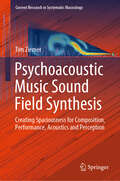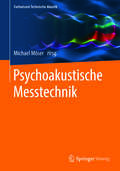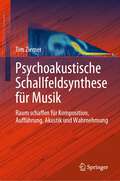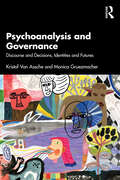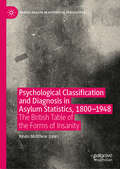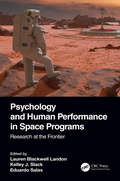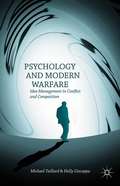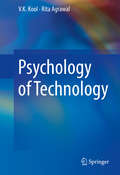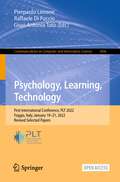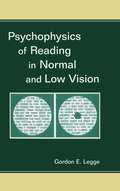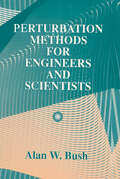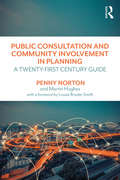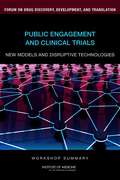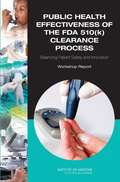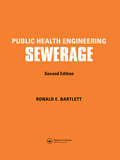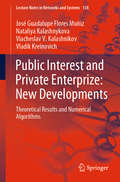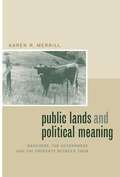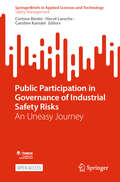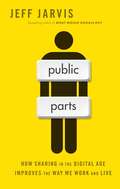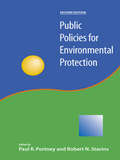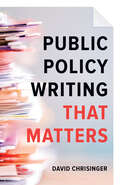- Table View
- List View
Psychoacoustic Music Sound Field Synthesis: Creating Spaciousness for Composition, Performance, Acoustics and Perception (Current Research in Systematic Musicology #7)
by Tim ZiemerThis book provides a broad overview of spaciousness in music theory, from mixing and performance practice, to room acoustics, psychoacoustics and audio engineering, and presents the derivation, implementation and experimental validation of a novel type of spatial audio system. Discussing the physics of musical instruments and the nature of auditory perception, the book enables readers to precisely localize synthesized musical instruments while experiencing their timbral variance and spatial breadth.Offering interdisciplinary insights for novice music enthusiasts and experts in the field of spatial audio, this book is suitable for anyone interested in the study of music and musicology and the application of spatial audio mixing, or those seeking an overview of the state of the art in applied psychoacoustics for spatial audio.
Psychoakustische Messtechnik (Fachwissen Technische Akustik)
by Michael MöserDieser Band der Reihe Fachwissen Technische Akustik beschreibt die Grundlagen der Schallanalyse sowie die wichtigsten psychoakustischen Kenngrößen. Der heute in zahlreichen Regelwerken überwiegend zur Messung und Beurteilung von Schallpegeln verwendete A-bewertete Schalldruckpegel stellt nur eine sehr grobe Näherung an die Lautstärkewahrnehmung dar. Darüber hinaus ist ein geringer A-bewerteter Schalldruckpegel nicht immer gleichbedeutend mit akustischem „Wohlbefinden“. Insbesondere in der Fahrzeugakustik und im Produkt-Sound-Design werden psychoakustische Messverfahren eingesetzt, um eine gehörgerechtere Schallanalyse zu ermöglichen. In dem Beitrag "Psychoakustische Messtechnik" werden ausgehend von den Grundlagen der gehörgerechten Schallanalyse (Hörschwelle, Verdeckungseffekte, Frequenzgruppen) über die wichtigsten psychoakustischen Kenngrößen elementarer Wahrnehmungskomponenten, wie Lautstärkepegel, Lautheit, Verhältnistonhöhe, Tonhaltigkeit, Schärfe, Rauhigkeit, Schwankungsstärke, Klanghaftigkeit auch psychoakustische Kenngrößen komplexer Wahrnehmungskomponenten, wie Lästigkeit und Wohlklang beschrieben. Den Abschluss des Beitrags bildet ein Abschnitt zum binauralen Hören (Kunstkopfmesstechnik) mit den Themen Lateralisation, Lokalisation, interauraler Korrelation und der binauralen Lautheit.
Psychoakustische Schallfeldsynthese für Musik: Raum schaffen für Komposition, Aufführung, Akustik und Wahrnehmung
by Tim ZiemerDieses Buch bietet einen umfassenden Überblick über die Räumlichkeit in der Musiktheorie, von der Abmischung und Aufführungspraxis bis hin zur Raumakustik, Psychoakustik und Tontechnik, und stellt die Ableitung, Implementierung und experimentelle Validierung eines neuartigen räumlichen Audiosystems vor. Durch die Erörterung der Physik von Musikinstrumenten und der Natur der auditiven Wahrnehmung ermöglicht das Buch den Lesern, synthetische Musikinstrumente präzise zu lokalisieren und gleichzeitig ihre klangliche Varianz und räumliche Weite zu erleben. Dieses Buch bietet interdisziplinäre Einblicke für Musikneulinge und Experten auf dem Gebiet der räumlichen Audiotechnik. Es eignet sich für alle, die sich für das Studium von Musik und Musikwissenschaft und die Anwendung von räumlichen Audiomischungen interessieren oder einen Überblick über den Stand der Technik in der angewandten Psychoakustik für räumliches Audio suchen.
Psychoanalysis and Governance: Discourse and Decisions, Identities and Futures
by Kristof Van Assche Monica GruezmacherPsychoanalysis and Governance makes a cogent argument for the use of psychoanalytic perspectives in the understanding of governance, the process of collective decision-making that maintains and reshapes communities.This book is highly relevant to those interested in the ever-expanding field of applications of psychoanalysis and for all those willing to observe the discursive and affective underpinnings of public policy, administration, and planning. It locates the potential for self-analysis and self-transformation within governance, yet also indicates governance as the confluence of diverging understandings of the ideas of community and governance itself, as the place where competing desires and variegated patterns of fears and hopes collide and hold the transformational potential to destabilize the community.Building on Freudian, Lacanian, and other psychoanalytic traditions, the book enriches our understanding of governance, the way communities remember and forget, are haunted by the past, remain untransparent to themselves yet also retain the possibility of reinvention, of imagining alternative selves, new futures, and discover paths to move in that direction. This book will be a suitable for psychoanalysts, planners, and all those interested in informed governance.
Psychological Classification and Diagnosis in Asylum Statistics, 1800 - 1948: The British Table of the Forms of Insanity (Mental Health in Historical Perspective)
by Kevin Matthew JonesThis book provides a detailed examination of the questions that preoccupied British alienists throughout the second half of the nineteenth century. Was insanity one disorder with different forms or a set of distinct natural kinds that each had different causes, symptoms, and outlooks? Was it possible to devise a standardised classification of the insanities that provides a scientific basis to psychological diagnosis? Could statistics on psychological diagnosis provide data to help reveal the nature of insanity? The classification at the centre of these debates, the Medico-Psychological Association’s Table of the Forms of Insanity, caused deep divisions that took decades to resolve and hampered efforts to develop asylum medical statistics on psychological diagnosis. The use of the classification in national medical statistics was tantamount to being the standard classification for the asylum. As the appeal of statistics grew within medical circles, the debates intensified, and the divisions grew deeper. Despite lofty aims and years of debate, attempts to develop national statistics on psychological diagnosis had achieved very little by the beginning of the twentieth century. The failure of these efforts, hampered by the unwieldy processes adopted by Lunacy administration, led to the Table of the Forms falling into obscurity after its final set of revisions in 1932. In presenting for the first time the debates surrounding the Table of the Forms of Insanity, this volume calls for a re-evaluation of the history of psychiatric classification through its exploration of the underappreciated links between the standardisation of psychological diagnosis and the development of mental health statistics. By interrogating the links between asylum governance and the clinic, this book presents considerations on classification that still resound today, and provides valuable reading for scholars interested in the social history of medicine, the history of psychiatry, and the history of science.
Psychology and Human Performance in Space Programs: Research at the Frontier
by Lauren Blackwell Landon; Kelley J. Slack; Eduardo SalasIn Psychology and Human Performance in Space Programs: Research at the Frontier, leading space researchers from multiple fields of expertise summarize the recent growth of knowledge, the resulting tools and techniques, and the research still needed to protect humans in space. Making use of cutting-edge research and development related to composing, training, and supporting astronaut crews who will live and work together for future missions to Mars, this book examines the current practices of leaders in the field both at NASA and in academia. Presenting astronaut data alongside data from analogous extreme environments such as mission simulation habitats, this volume helpfully contrasts and compares to examine the lessons that can be learned from other approaches. Using the context of current International Space Station missions, the book discusses the influence of human factors and physiological health on individual and team job performance and social cohesion. With an overview of the physical and psychological hazards of space, and the challenges posed by conducting space-related applied psychology research, this volume uses the context of a long-duration Mars mission as a lens through which to discuss adaptation and resilience, technical and team training, technological advances related to working and living in space, and human interaction with onboard systems. Additionally, the book includes an essay from retired astronaut Clay Anderson on his experiences in space and thoughts on future missions to the moon and Mars. This first of two volumes will be of interest to professionals in the field of human factors and psychology at work, as well as academics examining human performance in extreme environments and aerospace.
Psychology and Modern Warfare
by Michael Taillard Holly GiscoppaThroughout history, both military and commercial entities around the world have utilized these methods, and even since the formalization of psychological operations during WW2 our methods have improved greatly, but we are still only touching the 'tip of the iceberg', so to speak, of what is truly possible.
Psychology of Entertainment: The Psychology Of Its Appeal (Routledge Communication Series)
by Jennings Bryant Peter VordererAs entertainment becomes a trillion-dollar-a-year industry worldwide, as our modern era increasingly lives up to its label of the "entertainment age," and as economists begin to recognize that entertainment has become the driving force of the new world economy, it is safe to say that scholars are beginning to take entertainment seriously. The scholarly spin on entertainment has been manifested in traditional ways, as well as innovative ones. Representing the current state of theory and research, Psychology of Entertainment promises to be the most comprehensive and up-to-date volume on entertainment. It serves to define the new area of study and provides a theoretical spin for future work in the area.Divided into three basic parts, this book:*addresses the fundamental mechanisms and processes involved in orienting to and selecting entertainment fare, as well as receiving and processing it;*explores the mechanisms and processes by which we are entertained by the media messages we select and receive; and*provides an opportunity for the application of well-established as well as emerging psychological and psychobiological theories to be applied to the study of entertainment in ways that seldom have been utilized previously.Psychology of Entertainment will appeal to scholars, researchers, and graduate students in media studies and mass communication, psychology, marketing, and other areas contributing to the entertainment studies area.
Psychology of Technology
by V. K. Kool Rita AgrawalThis unique treatise expands on the philosophy of technology to argue for a psychology of technology based on the complex relationships between psychology, biology and technology, especially in the light of our relationships with our digital devices, our online lives, and our human experience. Drawing from disciplines ranging from philosophy and evolution to cognition and neuroscience, it examines myriad aspects of the brain's creative development: the cognitive, sensory, and motor processes that enable technological progress and its resulting efficiencies and deficiencies along with our discomforts and pleasures. These experiences are key to behavioral and affective processes in technology, manifest in such diverse phenomena as multitasking, the shift in tech design from ergonomics to hedonomics, and the many types of online problem behaviors. Through these rich pages, readers can understand more deeply the history and future of human adjustment and adaptation in an environment intertwined with technology--and, with the ascendance of video games and virtual reality, new conceptions of the human self. Among the topics covered: Could we have remained a tech-devoid society? Technology, ergonomics and the non-executive functions of our body. New directions in brain-computer interface. From avatars and agents to virtual reality technology. On measuring affective responses to objects. Psychology, technology, ethics, and culture. A timely lens on a field that will grow in importance as it shapes our existence, Psychology of Technology will be read and discussed by not only psychologists, social scientists, and behavioral scientists, but also by technology designers and developers and those in biotechnology.
Psychology, Learning, Technology: First International Conference, PLT 2022, Foggia, Italy, January 19–21, 2022, Revised Selected Papers (Communications in Computer and Information Science #1606)
by Pierpaolo Limone Raffaele Di Fuccio Giusi Antonia TotoThis open access book constitutes the refereed proceedings of 1st International Workshop on Psychology, Learning, Technology, PLT 2022, Foggia, Italy, during January 2022. The 8 full papers presented here were carefully reviewed and selected from 23 submissions. In addition, one invited paper is also included. Psychology, Learning, ad Technology Conference (PLT2022) aims to explore learning paths that incorporate digital technologies in innovative and transformative ways and the improvement of the psychological and relational life. The conference includes topics about the methodology of application of the ICT tools in psychology and education: from blended learning to the application of artificial intelligence in education; from the teaching, learning, and assessment strategies and practices to the new frontiers on Human-Computer Interaction.
Psychology, Learning, Technology: Second International Conference, PLT 2022, Foggia, Italy, November 17–18, 2022, Revised Selected Papers (Communications in Computer and Information Science #2089)
by Raffaele Di Fuccio Giusi Antonia TotoThis book constitutes the refereed proceedings of Second International Workshop on Psychology, Learning, Technology, PLT 2022, which took place in Foggia, Italy, in November 2022. The 14 full papers were carefully reviewed and selected from 42 submissions. The papers were organized in topical sections as follows: Digital psychology and digital setting; advances in technology enhanced learning and teaching; and bilingualism and second language learning.
Psychophysics of Reading in Normal and Low Vision
by Gordon E. LeggeWritten by a leader in the field, this book discusses the role of vision in reading. The author describes the influence of physical properties of text on reading performance and the implications for information processing in the visual pathways. He explores different forms of low vision that affect reading, text characteristics that optimize reading for those with low vision, principles underlying the legibility of text, and guidelines for displaying text. Special topics include the role of the magnocellular pathway in reading and dyslexia, Braille reading, and fonts for highway signs. An accompanying CD contains reprints of the seminal series of articles by Gordon E. Legge and colleagues published between 1985 and 2001.
Psychosocial Explorations of Film and Television Viewing
by Jo Whitehouse-HartMost people have, at some point in their lives, experienced powerful, often strange and disconcerting, responses to films and television programmes of which they cannot always make sense. Psychosocial Explorations of Film and Television Viewing takes as its subject the seemingly mundane and everyday activity of watching television and films in the home, arguing that the affective and emotional experiences generated for audiences make this activity in fact extraordinary. Based on a fascinating empirical study of audiences' "favourite" films and television programmes, the book unravels the biographical and emotional intensity of viewing, from a psychosocial perspective. Drawing on insights from psychoanalysis including the work of Sigmund Freud, Melanie Klein, Donald Winnicott, Wilfred Bion and Christopher Bollas, and sociological theorists such as Pierre Bourdieu, the book argues that viewing is a psychosocial activity which must consider the relationships and processes between "inner" and "outer" worlds. Important ideas from media audience research are revisited, to show that families and biographical experiences influence audience identification, interpretation and uses of television. The in-depth case studies show that whilst viewing can be pleasurable, in the conventional sense of enjoyment, it can also be anxiety-provoking and contradictory. Employing psychoanalytic methods for social and cultural research, this book is an important contribution to Media Studies, Film Studies, Cultural Studies and Psychosocial Studies.
Psychotropic Bacteria in FoodsDisease and Spoilage
by Allen A. KraftPsychrotrophic Bacteria in Foods: Disease and Spoilage presents a comprehensive review of psychrotrophic bacteria and other pathogens and their role in causing food spoilage in refrigerated and frozen foods. The book focuses on the growth, survival, and subsequent activity of these organisms, especially in meat and poultry products. Metabolic produ
Ptsd Compensation And Military Service
by Institute of Medicine National Research Council of the National AcademiesThe scars of war take many forms: the limb lost, the illness brought on by a battlefield exposure, and, for some, the psychological toll of encountering an extremely traumatic event. PTSD Compensation and Military Service presents a thorough assessment of how the U.S. Department of Veterans Affairs evaluates veterans with possible posttraumatic stress disorder and determines the level of disability support to which they are entitled. The book presents a history of mental health disability compensation of military personnel and reviews the current compensation and pension examination procedure and disability determination methodology. It offers a number of recommendations for changes that would improve the fairness, consistency, and scientific foundation of this vital program. This book will be of interest and importance to policy makers, veterans affairs groups, the armed forces, health care organizations, and veterans themselves.
Public Consultation and Community Involvement in Planning: A twenty-first century guide
by Penny Norton Martin HughesPublic Consultation and Community Involvement in Planning is the definitive introduction to public consultation for developers, students and planners. The past decade has seen a complete transformation in consultation and community relations in the UK, from increased requirements to consult, to the introduction of neighbourhood planning and a revolution in online communication. Public Consultation and Community Involvement in Planning takes readers through consultation from the basics right through to emerging trends to demonstrate how a successful consultation process can benefit both the developers and the local community. The book begins with a definition of consultation and community involvement and an explanation of their role within the development process, before going on to clarify the legal, ethical, practical and ideological concerns to be addressed by the consultation process. Consultation strategy is explored step by step, and social media and online consultation is explored in detail. This is the first comprehensive guide to modern public consultation within the UK development sector and will be essential reading for developers, students and planners.
Public Engagement and Clinical Trials: New Models and Disruptive Technologies
by Institute of Medicine Forum on Drug Discovery, Development, and Translation Victoria Weisfeld Anne B. Claiborne Board on Health Sciences Policy Rebecca A. EnglishClinical trials provide essential information needed to turn basic medical research findings into patient treatments. New treatments must be studied in large numbers of humans to find out whether they are effective and to assess any harm that may arise from treatment. There is growing recognition among many stakeholders that the U.S. clinical trials enterprise is unable to keep pace with the national demand for research results. The IOM, along with the Mount Sinai School of Medicine, held a workshop June 27-28, 2011, to engage stakeholders and experts in a discussion about possible solutions to improve public engagement in clinical trials.
Public Health Effectiveness of the Fda 510(K) Clearance Process: Balancing Patient Safety and Innovation
by Institute of Medicine of the National AcademiesThe Food and Drug Administration (FDA) is responsible for assuring that medical devices are safe and effective before they go on the market. As part of its assessment of FDA's premarket clearance process for medical devices, the IOM held a workshop June 14-15 to discuss how to best balance patient safety and technological innovation. This document summarizes the workshop.
Public Health Engineering: Sewerage, Second Edition
by R.E. BartlettThis broad-based book covers topics in sewage treatment from site investigation through to design, construction and operation. Data and design charts are given in an appendix.
Public Interest and Private Enterprize: Theoretical Results and Numerical Algorithms (Lecture Notes in Networks and Systems #138)
by Nataliya Kalashnykova Vladik Kreinovich José Guadalupe Flores Muñiz Viacheslav V. KalashnikovThis book deals with the effect of public and semi-public companies on economy. In traditional economic models, several private companies – interested in maximizing their profit – interact (e.g., compete) with each other. Such models help to avoid wild oscillation in production and prices (typical for uncontrolled competition), and to come up with a stable equilibrium solution. The problems become very complex if we take into account the presence of public and semi-public companies – that are interested in public good as well as in the profit. The book contains theoretical results and numerical techniques for computing resulting equilibria. As a case study, it considers the problem of selecting optimal tolls for the public roads – tolls that best balance the public good and the need to recover the cost of building the roads. It is recommended to specialists in economics as well as to students interested in learning the corresponding economic models.
Public Lands and Political Meaning: Ranchers, the Government, and the Property Between Them
by Karen R. MerrillThe history behind the recurring "sagebrush rebellions" in the American West, showing how (before environmentalists entered the fray) ranchers and the feds struggled over the uses of public lands, from the days when ranchers wanted more government support to the virulent anti-federal position that remains.
Public Participation in Governance of Industrial Safety Risks: An Uneasy Journey (SpringerBriefs in Applied Sciences and Technology)
by Corinne Bieder Hervé Laroche Caroline KamatéThis open access book contributes to the increasing trend toward greater public participation in decision-making in many areas of public life, particularly in the field of the environment and sustainable development. It describes the outcome of a two-day workshop, organized by the Foundation for an Industrial Safety Culture in 2023, that addresses the continuing sensitivities surround the impact of hazardous industrial activities. Public Participation in Governance of Industrial Safety Risks brings together international academic experts as well as industrial and institutional representatives to shed light on the topics discussed during this workshop. Through the viewpoints of experts from various disciplines, industrial sectors, and countries, it offers an opportunity to gain a better grasp of the multiplicity and complexity of participatory processes and to understand their expected benefits, their drawbacks, and potential pitfalls. The work supports the making of better-informed decisions, especially by industrial or regulatory actors, to engage or not with public participation.
Public Parts
by Jeff JarvisA visionary and optimistic thinker examines the tension between privacy and publicness that is transforming how we form communities, create identities, do business, and live our lives.Thanks to the internet, we now live--more and more--in public. More than 750 million people (and half of all Americans) use Facebook, where we share a billion times a day. The collective voice of Twitter echoes instantly 100 million times daily, from Tahrir Square to the Mall of America, on subjects that range from democratic reform to unfolding natural disasters to celebrity gossip. New tools let us share our photos, videos, purchases, knowledge, friendships, locations, and lives.Yet change brings fear, and many people--nostalgic for a more homogeneous mass culture and provoked by well-meaning advocates for privacy--despair that the internet and how we share there is making us dumber, crasser, distracted, and vulnerable to threats of all kinds. But not Jeff Jarvis.In this shibboleth-destroying book, Public Parts argues persuasively and personally that the internet and our new sense of publicness are, in fact, doing the opposite. Jarvis travels back in time to show the amazing parallels of fear and resistance that met the advent of other innovations such as the camera and the printing press. The internet, he argues, will change business, society, and life as profoundly as Gutenberg's invention, shifting power from old institutions to us all.Based on extensive interviews, Public Parts introduces us to the men and women building a new industry based on sharing. Some of them have become household names--Facebook's Mark Zuckerberg, Google's Eric Schmidt, and Twitter's Evan Williams. Others may soon be recognized as the industrialists, philosophers, and designers of our future. Jarvis explores the promising ways in which the internet and publicness allow us to collaborate, think, ways--how we manufacture and market, buy and sell, organize and govern, teach and learn. He also examines the necessity as well as the limits of privacy in an effort to understand and thus protect it. This new and open era has already profoundly disrupted economies, industries, laws, ethics, childhood, and many other facets of our daily lives. But the change has just begun. The shape of the future is not assured. The amazing new tools of publicness can be used to good ends and bad. The choices--and the responsibilities--lie with us. Jarvis makes an urgent case that the future of the internet--what one technologist calls "the eighth continent"--requires as much protection as the physical space we share, the air we breathe, and the rights we afford one another. It is a space of the public, for the public, and by the public. It needs protection and respect from all of us. As Secretary of State Hillary Clinton said in the wake of the uprisings in the Middle East, "If people around the world are going to come together every day online and have a safe and productive experience, we need a shared vision to guide us." Jeff Jarvis has that vision and will be that guide.
Public Policies for Environmental Protection
by Robert N. Stavins Paul Professor PortneyThe first edition of Public Policies for Environmental Protection contributed significantly to the incorporation of economic analysis in the study of environmental policy. Fully revised to account for changes in the institutional, legal, and regulatory framework of environmental policy, the second edition features updated chapters on the EPA and federal regulation, air and water pollution policy, and hazardous and toxic substances. It includes entirely new chapters on market-based environmental policies, global climate change, solid waste, and, for the first time, coverage of the Safe Drinking Water Act. Portney, Stavins, and their contributors provide an invaluable resource for researchers, policymakers, industry professionals, and journalists---anyone who needs up-to-date information on U.S. environmental policy. With their careful explanation of policy alternatives, the authors provide an ideal book for students in courses about environmental economics or environmental politics.
Public Policy Writing That Matters
by David ChrisingerHone your public policy writing—and make a significant impact on the world.Students and professionals across a variety of disciplines need to write public policy in a manner that inspires action and genuine change. You may have amazing ideas about how to improve the world, but if you aren’t able to communicate these ideas well, they simply won’t become reality. In Public Policy Writing That Matters, communications specialist David Chrisinger argues that public policy writing is most persuasive when it tells clear, concrete stories about people doing things. Combining helpful hints and cautionary tales with writing exercises and excerpts from sample policy documents, Chrisinger teaches readers to craft concise, story-driven pieces that exceed the stylistic requirements and limitations of traditional policy writing.Too often, public policy writing is convoluted, opaque, and exclusive. Chrisinger, who teaches introductory policy writing courses around the country, offers a step-by-step guide for anyone interested in planning, organizing, developing, writing, and revising accessible public policy. From the most effective use of data visualization, the best way to write a sentence, and the ideal moment to add a compelling anecdote to advice on using facts to strengthen an argument, this little book, inspired by Strunk & White’s classic style guide, will allow anyone crafting public policy to make a bigger impact. Aimed at helping students and professionals overcome their default impulses to merely "explain," this book reveals proven, classroom-tested tips for writing sophisticated policy that is also easy to understand. This practical, concise handbook will not only aid students throughout graduate school but will also remain a reference to consult throughout their professional careers. A vital tool for any policy writer or analyst, Public Policy Writing That Matters is a book for everyone passionate about using writing to effect real and lasting change.
